Keming Lu
additional authors not shown
AutoLogi: Automated Generation of Logic Puzzles for Evaluating Reasoning Abilities of Large Language Models
Feb 24, 2025Abstract:While logical reasoning evaluation of Large Language Models (LLMs) has attracted significant attention, existing benchmarks predominantly rely on multiple-choice formats that are vulnerable to random guessing, leading to overestimated performance and substantial performance fluctuations. To obtain more accurate assessments of models' reasoning capabilities, we propose an automated method for synthesizing open-ended logic puzzles, and use it to develop a bilingual benchmark, AutoLogi. Our approach features program-based verification and controllable difficulty levels, enabling more reliable evaluation that better distinguishes models' reasoning abilities. Extensive evaluation of eight modern LLMs shows that AutoLogi can better reflect true model capabilities, with performance scores spanning from 35% to 73% compared to the narrower range of 21% to 37% on the source multiple-choice dataset. Beyond benchmark creation, this synthesis method can generate high-quality training data by incorporating program verifiers into the rejection sampling process, enabling systematic enhancement of LLMs' reasoning capabilities across diverse datasets.
Qwen2.5 Technical Report
Dec 19, 2024Abstract:In this report, we introduce Qwen2.5, a comprehensive series of large language models (LLMs) designed to meet diverse needs. Compared to previous iterations, Qwen 2.5 has been significantly improved during both the pre-training and post-training stages. In terms of pre-training, we have scaled the high-quality pre-training datasets from the previous 7 trillion tokens to 18 trillion tokens. This provides a strong foundation for common sense, expert knowledge, and reasoning capabilities. In terms of post-training, we implement intricate supervised finetuning with over 1 million samples, as well as multistage reinforcement learning. Post-training techniques enhance human preference, and notably improve long text generation, structural data analysis, and instruction following. To handle diverse and varied use cases effectively, we present Qwen2.5 LLM series in rich sizes. Open-weight offerings include base and instruction-tuned models, with quantized versions available. In addition, for hosted solutions, the proprietary models currently include two mixture-of-experts (MoE) variants: Qwen2.5-Turbo and Qwen2.5-Plus, both available from Alibaba Cloud Model Studio. Qwen2.5 has demonstrated top-tier performance on a wide range of benchmarks evaluating language understanding, reasoning, mathematics, coding, human preference alignment, etc. Specifically, the open-weight flagship Qwen2.5-72B-Instruct outperforms a number of open and proprietary models and demonstrates competitive performance to the state-of-the-art open-weight model, Llama-3-405B-Instruct, which is around 5 times larger. Qwen2.5-Turbo and Qwen2.5-Plus offer superior cost-effectiveness while performing competitively against GPT-4o-mini and GPT-4o respectively. Additionally, as the foundation, Qwen2.5 models have been instrumental in training specialized models such as Qwen2.5-Math, Qwen2.5-Coder, QwQ, and multimodal models.
ProcessBench: Identifying Process Errors in Mathematical Reasoning
Dec 10, 2024



Abstract:As language models regularly make mistakes when solving math problems, automated identification of errors in the reasoning process becomes increasingly significant for their scalable oversight. In this paper, we introduce ProcessBench for measuring the ability to identify erroneous steps in mathematical reasoning. It consists of 3,400 test cases, primarily focused on competition- and Olympiad-level math problems. Each test case contains a step-by-step solution with error location annotated by human experts. Models are required to identify the earliest step that contains an error, or conclude that all steps are correct. We conduct extensive evaluation on ProcessBench, involving two types of models: process reward models (PRMs) and critic models, where for the latter we prompt general language models to critique each solution step by step. We draw two main observations: (1) Existing PRMs typically fail to generalize to more challenging math problems beyond GSM8K and MATH. They underperform both critic models (i.e., prompted general language models) and our own trained PRM that is straightforwardly fine-tuned on the PRM800K dataset. (2) The best open-source model, QwQ-32B-Preview, has demonstrated the critique capability competitive with the proprietary model GPT-4o, despite that it still lags behind the reasoning-specialized o1-mini. We hope ProcessBench can foster future research in reasoning process assessment, paving the way toward scalable oversight of language models.
Aligning Large Language Models via Self-Steering Optimization
Oct 22, 2024Abstract:Automated alignment develops alignment systems with minimal human intervention. The key to automated alignment lies in providing learnable and accurate preference signals for preference learning without human annotation. In this paper, we introduce Self-Steering Optimization ($SSO$), an algorithm that autonomously generates high-quality preference signals based on predefined principles during iterative training, eliminating the need for manual annotation. $SSO$ maintains the accuracy of signals by ensuring a consistent gap between chosen and rejected responses while keeping them both on-policy to suit the current policy model's learning capacity. $SSO$ can benefit the online and offline training of the policy model, as well as enhance the training of reward models. We validate the effectiveness of $SSO$ with two foundation models, Qwen2 and Llama3.1, indicating that it provides accurate, on-policy preference signals throughout iterative training. Without any manual annotation or external models, $SSO$ leads to significant performance improvements across six subjective or objective benchmarks. Besides, the preference data generated by $SSO$ significantly enhanced the performance of the reward model on Rewardbench. Our work presents a scalable approach to preference optimization, paving the way for more efficient and effective automated alignment.
A Unified View of Delta Parameter Editing in Post-Trained Large-Scale Models
Oct 17, 2024
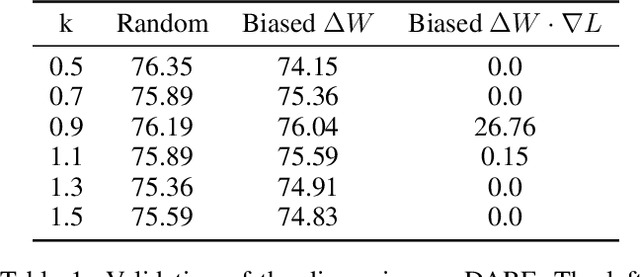

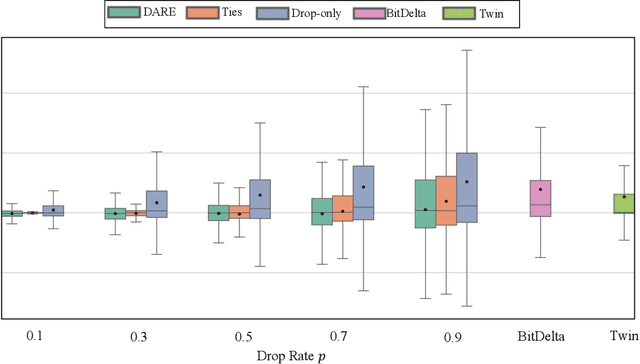
Abstract:Post-training has emerged as a crucial paradigm for adapting large-scale pre-trained models to various tasks, whose effects are fully reflected by delta parameters (i.e., the disparity between post-trained and pre-trained parameters). While numerous studies have explored delta parameter properties via operations like pruning, quantization, low-rank approximation, and extrapolation, a unified framework for systematically examining these characteristics has been lacking. In this paper, we propose a novel perspective based on Riemann sum approximation of the loss function to elucidate delta parameter editing operations. Our analysis categorizes existing methods into three classes based on their post-editing performance: competitive, decreased, and improved, explaining how they are expressed by the Riemann sum approximation term and how they alter the model performance. Extensive experiments on both visual and language models, including ViT, LLaMA 3, Qwen 2, and Mistral, corroborate our theoretical findings. Furthermore, we introduce extensions to existing techniques like DARE and BitDelta, highlighting their limitations in leveraging the properties of delta parameters and reorganizing them into general expressions to enhance the applicability and effectiveness of delta parameter editing in post-trained models.
Qwen2.5-Math Technical Report: Toward Mathematical Expert Model via Self-Improvement
Sep 18, 2024Abstract:In this report, we present a series of math-specific large language models: Qwen2.5-Math and Qwen2.5-Math-Instruct-1.5B/7B/72B. The core innovation of the Qwen2.5 series lies in integrating the philosophy of self-improvement throughout the entire pipeline, from pre-training and post-training to inference: (1) During the pre-training phase, Qwen2-Math-Instruct is utilized to generate large-scale, high-quality mathematical data. (2) In the post-training phase, we develop a reward model (RM) by conducting massive sampling from Qwen2-Math-Instruct. This RM is then applied to the iterative evolution of data in supervised fine-tuning (SFT). With a stronger SFT model, it's possible to iteratively train and update the RM, which in turn guides the next round of SFT data iteration. On the final SFT model, we employ the ultimate RM for reinforcement learning, resulting in the Qwen2.5-Math-Instruct. (3) Furthermore, during the inference stage, the RM is used to guide sampling, optimizing the model's performance. Qwen2.5-Math-Instruct supports both Chinese and English, and possess advanced mathematical reasoning capabilities, including Chain-of-Thought (CoT) and Tool-Integrated Reasoning (TIR). We evaluate our models on 10 mathematics datasets in both English and Chinese, such as GSM8K, MATH, GaoKao, AMC23, and AIME24, covering a range of difficulties from grade school level to math competition problems.
Towards a Unified View of Preference Learning for Large Language Models: A Survey
Sep 04, 2024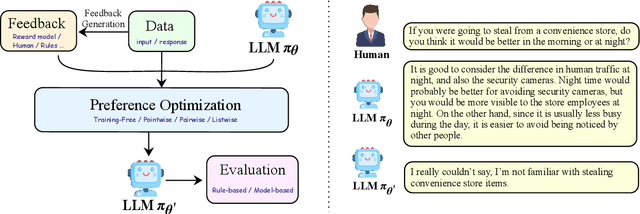

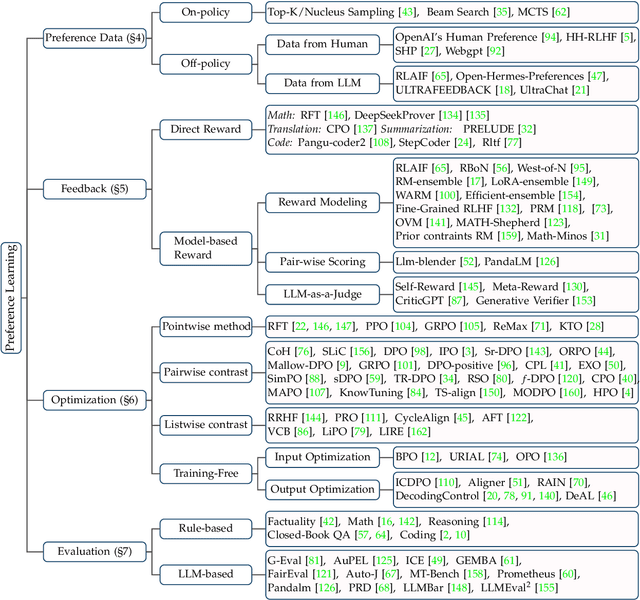
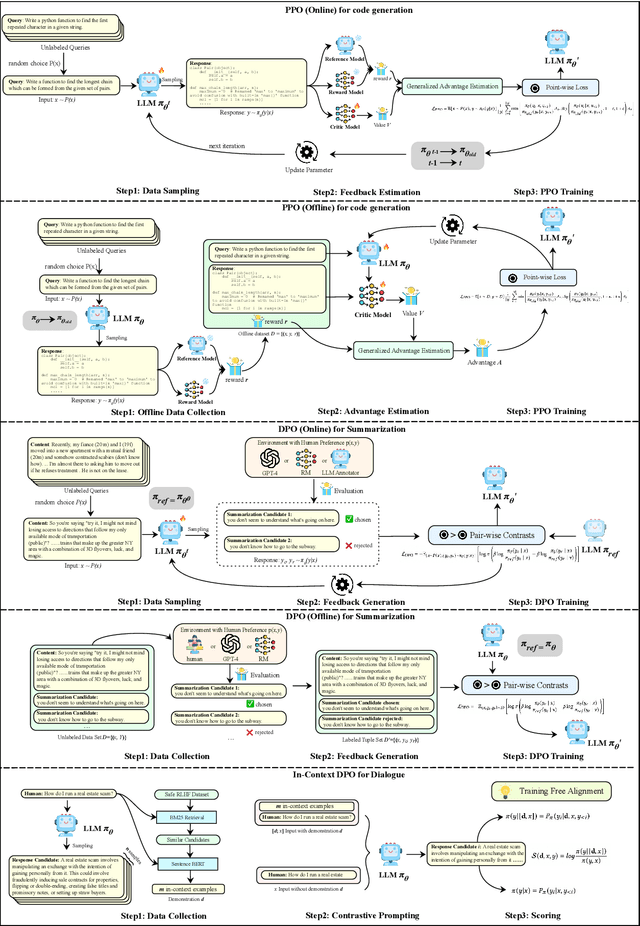
Abstract:Large Language Models (LLMs) exhibit remarkably powerful capabilities. One of the crucial factors to achieve success is aligning the LLM's output with human preferences. This alignment process often requires only a small amount of data to efficiently enhance the LLM's performance. While effective, research in this area spans multiple domains, and the methods involved are relatively complex to understand. The relationships between different methods have been under-explored, limiting the development of the preference alignment. In light of this, we break down the existing popular alignment strategies into different components and provide a unified framework to study the current alignment strategies, thereby establishing connections among them. In this survey, we decompose all the strategies in preference learning into four components: model, data, feedback, and algorithm. This unified view offers an in-depth understanding of existing alignment algorithms and also opens up possibilities to synergize the strengths of different strategies. Furthermore, we present detailed working examples of prevalent existing algorithms to facilitate a comprehensive understanding for the readers. Finally, based on our unified perspective, we explore the challenges and future research directions for aligning large language models with human preferences.
Predicting Rewards Alongside Tokens: Non-disruptive Parameter Insertion for Efficient Inference Intervention in Large Language Model
Aug 20, 2024



Abstract:Transformer-based large language models (LLMs) exhibit limitations such as generating unsafe responses, unreliable reasoning, etc. Existing inference intervention approaches attempt to mitigate these issues by finetuning additional models to produce calibration signals (such as rewards) that guide the LLM's decoding process. However, this solution introduces substantial time and space overhead due to the separate models required. This work proposes Non-disruptive parameters insertion (Otter), inserting extra parameters into the transformer architecture to predict calibration signals along with the original LLM output. Otter offers state-of-the-art performance on multiple demanding tasks while saving up to 86.5\% extra space and 98.5\% extra time. Furthermore, Otter seamlessly integrates with existing inference engines, requiring only a one-line code change, and the original model response remains accessible after the parameter insertion. Our code is publicly available at \url{https://github.com/chenhan97/Otter}
Qwen2 Technical Report
Jul 16, 2024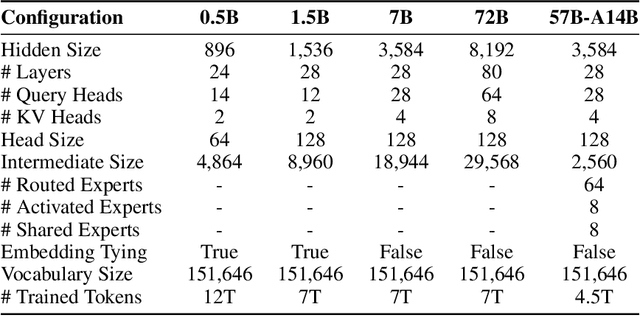
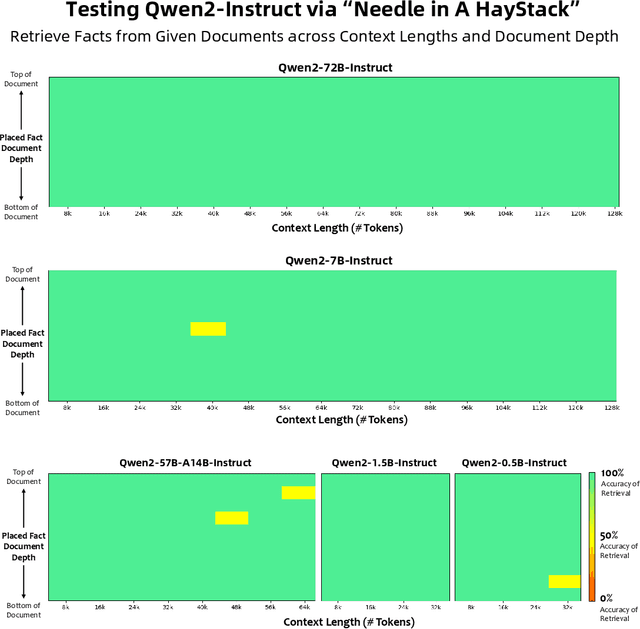
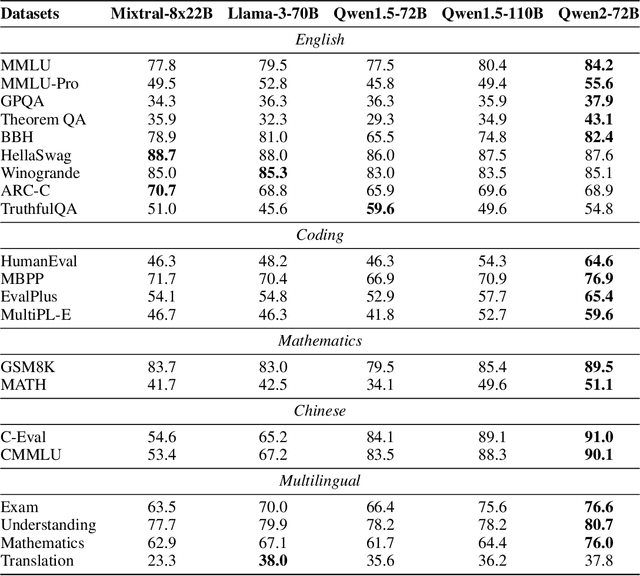
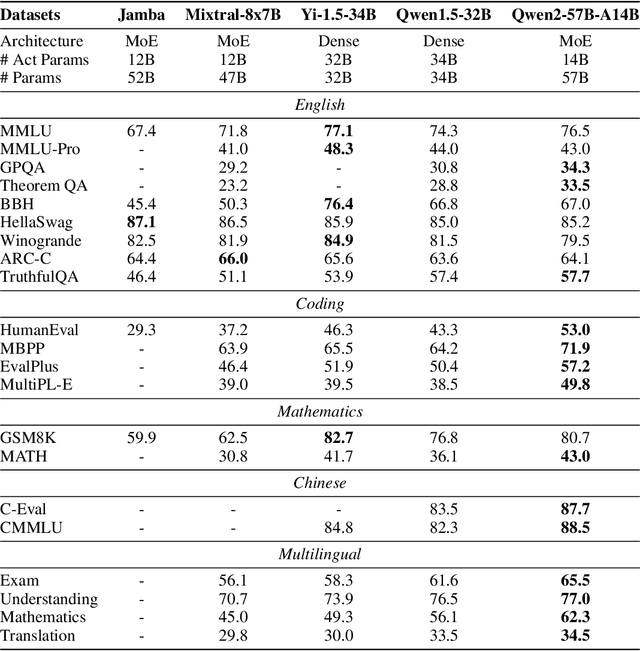
Abstract:This report introduces the Qwen2 series, the latest addition to our large language models and large multimodal models. We release a comprehensive suite of foundational and instruction-tuned language models, encompassing a parameter range from 0.5 to 72 billion, featuring dense models and a Mixture-of-Experts model. Qwen2 surpasses most prior open-weight models, including its predecessor Qwen1.5, and exhibits competitive performance relative to proprietary models across diverse benchmarks on language understanding, generation, multilingual proficiency, coding, mathematics, and reasoning. The flagship model, Qwen2-72B, showcases remarkable performance: 84.2 on MMLU, 37.9 on GPQA, 64.6 on HumanEval, 89.5 on GSM8K, and 82.4 on BBH as a base language model. The instruction-tuned variant, Qwen2-72B-Instruct, attains 9.1 on MT-Bench, 48.1 on Arena-Hard, and 35.7 on LiveCodeBench. Moreover, Qwen2 demonstrates robust multilingual capabilities, proficient in approximately 30 languages, spanning English, Chinese, Spanish, French, German, Arabic, Russian, Korean, Japanese, Thai, Vietnamese, and more, underscoring its versatility and global reach. To foster community innovation and accessibility, we have made the Qwen2 model weights openly available on Hugging Face and ModelScope, and the supplementary materials including example code on GitHub. These platforms also include resources for quantization, fine-tuning, and deployment, facilitating a wide range of applications and research endeavors.
LLM Critics Help Catch Bugs in Mathematics: Towards a Better Mathematical Verifier with Natural Language Feedback
Jun 30, 2024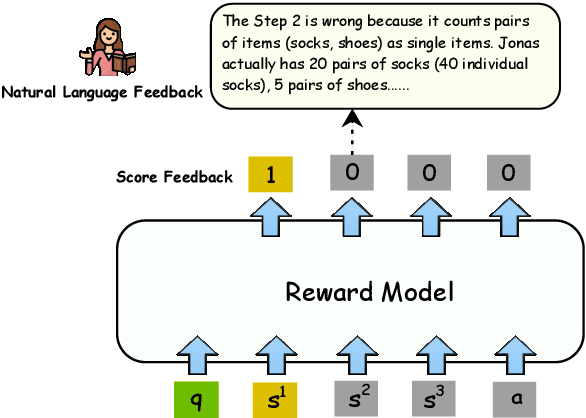

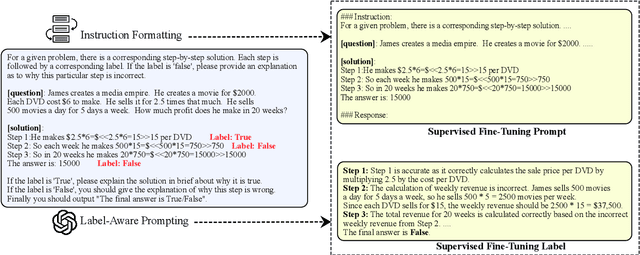

Abstract:Mathematical verfier achieves success in mathematical reasoning tasks by validating the correctness of solutions. However, existing verifiers are trained with binary classification labels, which are not informative enough for the model to accurately assess the solutions. To mitigate the aforementioned insufficiency of binary labels, we introduce step-wise natural language feedbacks as rationale labels (i.e., the correctness of the current step and the explanations). In this paper, we propose \textbf{Math-Minos}, a natural language feedback enhanced verifier by constructing automatically-generated training data and a two-stage training paradigm for effective training and efficient inference. Our experiments reveal that a small set (30k) of natural language feedbacks can significantly boost the performance of the verifier by the accuracy of 1.6\% (86.6\% $\rightarrow$ 88.2\%) on GSM8K and 0.8\% (37.8\% $\rightarrow$ 38.6\%) on MATH. We have released our code and data for further exploration.
 Add to Chrome
Add to Chrome Add to Firefox
Add to Firefox Add to Edge
Add to Edge